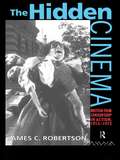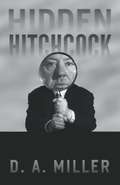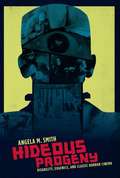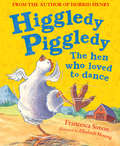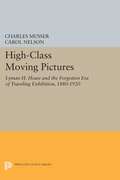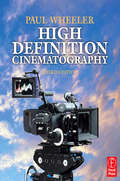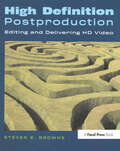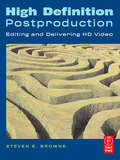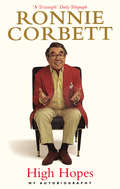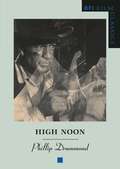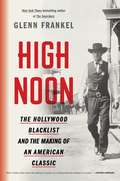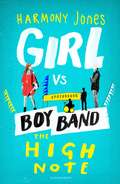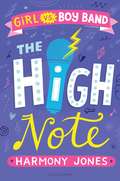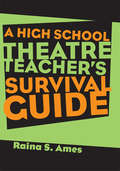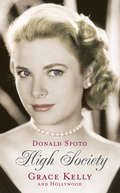- Table View
- List View
The Hidden Cinema: British Film Censorship in Action 1913-1972 (Cinema and Society)
by Dr James Robertson James RobertsonHow does film censorship work in Britain? Jim Robertson's new paperback edition of The Hidden Cinema argues that censorship has had a far greater influence on British film history than is often apparent, creating the `hidden cinema' of the title. Robertson charts the role of the British Board of Film Censors, established in 1913, and the histories of a variety of noteworthy films including Battleship Potemkin and No Orchids for Miss Blandish and revealing how censorship continues to exert a marked influence on many important films - like the controversial A Clockwork Orange - some of which have now vanished from British screens altogether. This edition includes a brand new section on Bernardo Bertolucci's Last Tango in Paris, immediately engulfed in censorship wrangles on its release in 1972.
The Hidden Cinema: British Film Censorship in Action 1913-1972 (Cinema and Society)
by Dr James Robertson James RobertsonHow does film censorship work in Britain? Jim Robertson's new paperback edition of The Hidden Cinema argues that censorship has had a far greater influence on British film history than is often apparent, creating the `hidden cinema' of the title. Robertson charts the role of the British Board of Film Censors, established in 1913, and the histories of a variety of noteworthy films including Battleship Potemkin and No Orchids for Miss Blandish and revealing how censorship continues to exert a marked influence on many important films - like the controversial A Clockwork Orange - some of which have now vanished from British screens altogether. This edition includes a brand new section on Bernardo Bertolucci's Last Tango in Paris, immediately engulfed in censorship wrangles on its release in 1972.
Hidden Hitchcock
by D. A. MillerNo filmmaker has more successfully courted mass-audience understanding than Alfred Hitchcock, and none has been studied more intensively by scholars. In Hidden Hitchcock, D. A. Miller does what seems impossible: he discovers what has remained unseen in Hitchcock’s movies, a secret style that imbues his films with a radical duplicity. Focusing on three films—Strangers on a Train, Rope, and The Wrong Man—Miller shows how Hitchcock anticipates, even demands a “Too-Close Viewer.” Dwelling within us all and vigilant even when everything appears to be in good order, this Too-Close Viewer attempts to see more than the director points out, to expand the space of the film and the duration of the viewing experience. And, thanks to Hidden Hitchcock, that obsessive attention is rewarded. In Hitchcock’s visual puns, his so-called continuity errors, and his hidden appearances (not to be confused with his cameos), Miller finds wellsprings of enigma. Hidden Hitchcock is a revelatory work that not only shows how little we know this best known of filmmakers, but also how near such too-close viewing comes to cinephilic madness.
Hidden Hitchcock
by D. A. MillerNo filmmaker has more successfully courted mass-audience understanding than Alfred Hitchcock, and none has been studied more intensively by scholars. In Hidden Hitchcock, D. A. Miller does what seems impossible: he discovers what has remained unseen in Hitchcock’s movies, a secret style that imbues his films with a radical duplicity. Focusing on three films—Strangers on a Train, Rope, and The Wrong Man—Miller shows how Hitchcock anticipates, even demands a “Too-Close Viewer.” Dwelling within us all and vigilant even when everything appears to be in good order, this Too-Close Viewer attempts to see more than the director points out, to expand the space of the film and the duration of the viewing experience. And, thanks to Hidden Hitchcock, that obsessive attention is rewarded. In Hitchcock’s visual puns, his so-called continuity errors, and his hidden appearances (not to be confused with his cameos), Miller finds wellsprings of enigma. Hidden Hitchcock is a revelatory work that not only shows how little we know this best known of filmmakers, but also how near such too-close viewing comes to cinephilic madness.
Hidden Hitchcock
by D. A. MillerNo filmmaker has more successfully courted mass-audience understanding than Alfred Hitchcock, and none has been studied more intensively by scholars. In Hidden Hitchcock, D. A. Miller does what seems impossible: he discovers what has remained unseen in Hitchcock’s movies, a secret style that imbues his films with a radical duplicity. Focusing on three films—Strangers on a Train, Rope, and The Wrong Man—Miller shows how Hitchcock anticipates, even demands a “Too-Close Viewer.” Dwelling within us all and vigilant even when everything appears to be in good order, this Too-Close Viewer attempts to see more than the director points out, to expand the space of the film and the duration of the viewing experience. And, thanks to Hidden Hitchcock, that obsessive attention is rewarded. In Hitchcock’s visual puns, his so-called continuity errors, and his hidden appearances (not to be confused with his cameos), Miller finds wellsprings of enigma. Hidden Hitchcock is a revelatory work that not only shows how little we know this best known of filmmakers, but also how near such too-close viewing comes to cinephilic madness.
Hidden Hitchcock
by D. A. MillerNo filmmaker has more successfully courted mass-audience understanding than Alfred Hitchcock, and none has been studied more intensively by scholars. In Hidden Hitchcock, D. A. Miller does what seems impossible: he discovers what has remained unseen in Hitchcock’s movies, a secret style that imbues his films with a radical duplicity. Focusing on three films—Strangers on a Train, Rope, and The Wrong Man—Miller shows how Hitchcock anticipates, even demands a “Too-Close Viewer.” Dwelling within us all and vigilant even when everything appears to be in good order, this Too-Close Viewer attempts to see more than the director points out, to expand the space of the film and the duration of the viewing experience. And, thanks to Hidden Hitchcock, that obsessive attention is rewarded. In Hitchcock’s visual puns, his so-called continuity errors, and his hidden appearances (not to be confused with his cameos), Miller finds wellsprings of enigma. Hidden Hitchcock is a revelatory work that not only shows how little we know this best known of filmmakers, but also how near such too-close viewing comes to cinephilic madness.
Hidden Hitchcock
by D. A. MillerNo filmmaker has more successfully courted mass-audience understanding than Alfred Hitchcock, and none has been studied more intensively by scholars. In Hidden Hitchcock, D. A. Miller does what seems impossible: he discovers what has remained unseen in Hitchcock’s movies, a secret style that imbues his films with a radical duplicity. Focusing on three films—Strangers on a Train, Rope, and The Wrong Man—Miller shows how Hitchcock anticipates, even demands a “Too-Close Viewer.” Dwelling within us all and vigilant even when everything appears to be in good order, this Too-Close Viewer attempts to see more than the director points out, to expand the space of the film and the duration of the viewing experience. And, thanks to Hidden Hitchcock, that obsessive attention is rewarded. In Hitchcock’s visual puns, his so-called continuity errors, and his hidden appearances (not to be confused with his cameos), Miller finds wellsprings of enigma. Hidden Hitchcock is a revelatory work that not only shows how little we know this best known of filmmakers, but also how near such too-close viewing comes to cinephilic madness.
Hidden Hitchcock
by D. A. MillerNo filmmaker has more successfully courted mass-audience understanding than Alfred Hitchcock, and none has been studied more intensively by scholars. In Hidden Hitchcock, D. A. Miller does what seems impossible: he discovers what has remained unseen in Hitchcock’s movies, a secret style that imbues his films with a radical duplicity. Focusing on three films—Strangers on a Train, Rope, and The Wrong Man—Miller shows how Hitchcock anticipates, even demands a “Too-Close Viewer.” Dwelling within us all and vigilant even when everything appears to be in good order, this Too-Close Viewer attempts to see more than the director points out, to expand the space of the film and the duration of the viewing experience. And, thanks to Hidden Hitchcock, that obsessive attention is rewarded. In Hitchcock’s visual puns, his so-called continuity errors, and his hidden appearances (not to be confused with his cameos), Miller finds wellsprings of enigma. Hidden Hitchcock is a revelatory work that not only shows how little we know this best known of filmmakers, but also how near such too-close viewing comes to cinephilic madness.
Hideous Progeny: Disability, Eugenics, and Classic Horror Cinema (PDF)
by Angela SmithTwisted bodies, deformed faces, aberrant behavior, and abnormal desires characterized the hideous creatures of classic Hollywood horror, which thrilled audiences with their sheer grotesqueness. Most critics have interpreted these traits as symptoms of sexual repression or as metaphors for other kinds of marginalized identities, yet Angela M. Smith conducts a richer investigation into the period's social and cultural preoccupations. She finds instead a fascination with eugenics and physical and cognitive debility in the narrative and spectacle of classic 1930s horror, heightened by the viewer's desire for visions of vulnerability and transformation.
Hideous Progeny: Disability, Eugenics, And Classic Horror Cinema (PDF) (Film And Culture Ser.)
by Angela SmithIntroduction: disability, eugenics, and classic horror cinema -- Eugenic reproduction: chimeras in Dracula and Frankenstein -- Enfreaking the classic horror genre: freaks -- Revelations and convulsions: spectacles of impairment in classic horror film -- Mad medicine: disability in the mad-doctor films -- Shock horror and death rays: disabling spectatorship -- Conclusion.
Higgledy Piggledy the Hen Who Loved to Dance
by Francesca SimonA delightful farmyard story full of energy and fun from Francesca Simon, author of the bestselling Horrid Henry series.
High-Class Moving Pictures: Lyman H. Howe and the Forgotten Era of Traveling Exhibition, 1880-1920
by Charles Musser Carol NelsonThe entrepreneur of phonograph concerts and motion-picture programs Lyman H. Howe was the leading traveling exhibitor of his time and the exemplar of an important but until now little examined aspect of American popular culture. This work, with its numerous and lively illustrations, uses his career to explore the world of itinerant showmen, who exhibited all motion pictures seen outside large cities during the 1890s and early 1900s. They frequently built cultural alliances with genteel city dwellers or conservative churchgoers and in later years favored "high-class" topics appealing to audiences uncomfortable with the plebeian nickelodeons. Bridging the fields of American studies and film history, the book reveals the remarkable sophistication with which exhibitors created their elaborate, evening-length programs to convey powerful ideological messages. Whether depicting the Spanish-American War, the 1900 Paris Exposition, or British colonialism in action, Howe's "cinema of reassurance" had many parallels with the music of John Philip Sousa.Originally published in 1991.The Princeton Legacy Library uses the latest print-on-demand technology to again make available previously out-of-print books from the distinguished backlist of Princeton University Press. These editions preserve the original texts of these important books while presenting them in durable paperback and hardcover editions. The goal of the Princeton Legacy Library is to vastly increase access to the rich scholarly heritage found in the thousands of books published by Princeton University Press since its founding in 1905.
High Definition Cinematography
by Paul WheelerHigh-definition is now ubiquitous in video production and High Definition Cinematography, Third Edition provides the explanations, definitions, and workflows that today's cinematographers and camera operators need to make the transition. Paul Wheeler will explain the high-definition process, suggest the best methods for filming, and help you choose the right camera and equipment for your crew with this comprehensive book. You'll also learn the different formats and when best to use them, how to create specific looks for different venues, and learn how to operate a wide variety of popular cameras.
High Definition Cinematography
by Paul WheelerHigh-definition is now ubiquitous in video production and High Definition Cinematography, Third Edition provides the explanations, definitions, and workflows that today's cinematographers and camera operators need to make the transition. Paul Wheeler will explain the high-definition process, suggest the best methods for filming, and help you choose the right camera and equipment for your crew with this comprehensive book. You'll also learn the different formats and when best to use them, how to create specific looks for different venues, and learn how to operate a wide variety of popular cameras.
High Definition Postproduction: Editing and Delivering HD Video
by Steven E. Browne* Real-world postproduction paths show how it's being done today * Numerous HD tables clear up what format is used for which purpose * Ample information on HDV * Debunks myths and answers common questions about HDAvoid costly missteps in postproduction and get it right the first time with this book. Written by an in-the-trenches professional who works with HD every day, High Definition Postproduction is an overview of this exciting opportunity for film and video production and postproduction professionals. High Definition production and editing is here and definitely a reality. High-def network shows are aired on a weekly basis. Several HD-only channels are well into their production schedules. HD is even used for major film productions and post production processes. However, unlike the existing 4x3, NTSC format, the HD world has many variables. This ability to choose various frame rates, frame sizes, bit rates, and color space options makes this an exciting, yet somewhat daunting challenge. The future may hold even more options as electronics continue to evolve and manufactures continue to exploit this format. Naturally, all of these options can lead to confusion and errors. This book begins with an overview of the HD format and then covers commonly-asked questions. A chapter on shooting details how to smooth the path for post. Postproduction workflows, including the digital intermediate, are covered in great detail, and are enhanced by real-world examples. From HDV to the high-end cameras used in Star Wars and Sin City, this book is your complete guide to HD.
High Definition Postproduction: Editing and Delivering HD Video
by Steven E. Browne* Real-world postproduction paths show how it's being done today * Numerous HD tables clear up what format is used for which purpose * Ample information on HDV * Debunks myths and answers common questions about HDAvoid costly missteps in postproduction and get it right the first time with this book. Written by an in-the-trenches professional who works with HD every day, High Definition Postproduction is an overview of this exciting opportunity for film and video production and postproduction professionals. High Definition production and editing is here and definitely a reality. High-def network shows are aired on a weekly basis. Several HD-only channels are well into their production schedules. HD is even used for major film productions and post production processes. However, unlike the existing 4x3, NTSC format, the HD world has many variables. This ability to choose various frame rates, frame sizes, bit rates, and color space options makes this an exciting, yet somewhat daunting challenge. The future may hold even more options as electronics continue to evolve and manufactures continue to exploit this format. Naturally, all of these options can lead to confusion and errors. This book begins with an overview of the HD format and then covers commonly-asked questions. A chapter on shooting details how to smooth the path for post. Postproduction workflows, including the digital intermediate, are covered in great detail, and are enhanced by real-world examples. From HDV to the high-end cameras used in Star Wars and Sin City, this book is your complete guide to HD.
High Hopes: My Autobiography
by Ronnie CorbettA true great of British comedy, Ronald ‘Ronnie’ Corbett, is hailed as one of the finest comedians of his generation.Son of an Edinburgh baker, Ronnie rose to fame as one half of the infamous Two Ronnies alongside Ronnie Barker. Known for his versatility, quick-wit, family-friendly dialogue, and meandering monologues, Corbett was a staple of British television for more than 50 years. In his autobiography, he tells the complete story, from his school technique of estimating the height of a girl before daring to ask her to dance, to his days as a night club barman in London, and finally, to his decades long career as a stand-up and sitcom star. Including tales of how he first met David Frost, John Cleese and Michael Palin, this book is written with all of Ronnie’s trademark warmth and wit.Celebrating his life and career, this is Ronnie’s own honest and definitive account of his truly dramatic journey.
High Noon (BFI Film Classics)
by Phillip DrummondMade in 1951, High Noon rapidly became one of the most celebrated and controversial Hollywood dramas of the post-war period. A grave, taut western about community and violence, High Noon collected a clutch of Oscars, helped to re-establish the dwindling fortunes of its star, Gary Cooper, and confirmed the stature of director Fred Zinnemann and producer Stanley Kramer. The film was also a flashpoint for the conflict between the US film industry and McCarthyite anti-communism: writer and associate producer Carl Foreman was hounded off the production and blacklisted. Phillip Drummond offers a detailed account of High Noon's troubled production context and its early public reception, along with career-summaries of the key participants. He analyzes the dramatic organization of the film with close reference to the original short story and Carl Foreman's script, and concludes with an invaluable overview of the long history of critical debates, focusing on questions of social identity and gender. The result is a fresh and nuanced reading of a major classic.Phillip Drummond is Lecturer in Film and Media Studies at the Institute of Education, University of London, UK.
High Noon (BFI Film Classics)
by Phillip DrummondMade in 1951, High Noon rapidly became one of the most celebrated and controversial Hollywood dramas of the post-war period. A grave, taut western about community and violence, High Noon collected a clutch of Oscars, helped to re-establish the dwindling fortunes of its star, Gary Cooper, and confirmed the stature of director Fred Zinnemann and producer Stanley Kramer. The film was also a flashpoint for the conflict between the US film industry and McCarthyite anti-communism: writer and associate producer Carl Foreman was hounded off the production and blacklisted. Phillip Drummond offers a detailed account of High Noon's troubled production context and its early public reception, along with career-summaries of the key participants. He analyzes the dramatic organization of the film with close reference to the original short story and Carl Foreman's script, and concludes with an invaluable overview of the long history of critical debates, focusing on questions of social identity and gender. The result is a fresh and nuanced reading of a major classic.Phillip Drummond is Lecturer in Film and Media Studies at the Institute of Education, University of London, UK.
High Noon: The Hollywood Blacklist and the Making of an American Classic
by Glenn FrankelFrom the New York Times-bestselling author of The Searchers, the revelatory story behind the classic movie High Noon and the toxic political climate in which it was created. It's one of the most revered movies of Hollywood's golden era. Starring screen legend Gary Cooper and Grace Kelly in her first significant film role, High Noon was shot on a lean budget over just thirty-two days but achieved instant box-office and critical success. It won four Academy Awards in 1953, including a best actor win for Cooper. And it became a cultural touchstone, often cited by politicians as a favorite film, celebrating moral fortitude. Yet what has been often overlooked is that High Noon was made during the height of the Hollywood blacklist, a time of political inquisition and personal betrayal. In the middle of the film shoot, screenwriter Carl Foreman was forced to testify before the House Committee on Un-American Activities about his former membership in the Communist Party. Refusing to name names, he was eventually blacklisted and fled the United States. (His co-authored screenplay for another classic, The Bridge on the River Kwai, went uncredited in 1957.) Examined in light of Foreman's testimony, High Noon's emphasis on courage and loyalty takes on deeper meaning and importance. In this book, Pulitzer Prize-winning journalist Glenn Frankel tells the story of the making of a great American Western, exploring how Carl Foreman's concept of High Noon evolved from idea to first draft to final script, taking on allegorical weight. Both the classic film and its turbulent political times emerge newly illuminated.
The High Note (Girl vs Boy Band #2)
by Harmony JonesLark's singing is BIG news on YouTube and she's finally starting to admit that she wants to be heard. But it seems that being a singer-songwriter means that it's not just her voice that's in the spotlight – it's her love life too! With pressure from two music executives – one of them her mum – to sign to their label and with irresistible pop sensation Abbey Road set to go on tour, Lark worries that the only boy she can really talk to about her fears and frustrations is about to leave … until Abbey Road ask her to be their opening act! Now Lark must find a way to listen to her heart, both on and off stage. Can she find the courage when it counts the most?The second book in a tween series featuring an aspiring singer-songwriter and the boy band that changes her life!
The High Note (Girl vs Boy Band #2)
by Harmony JonesA few months after winning her school's talent show with her original song Homesick, eighth-grader Lark's star is on the rise. Not only did she impress her classmates, but now she's making waves on YouTube, thanks to her friend Mimi uploading a video of Lark's singing. A record executive is interested in signing Lark to his label, which infuriates Lark's mom, who runs her own record label.Meanwhile, Lark's friends in the British boy band Abbey Road are still trying to make it big in the U. S. As they're being primed for fame, Lark worries that she's losing touch with her new friends . . . until they ask her to be an opening act. Can she find the courage to overcome her recurring stage fright in time to perform when it counts the most?
The High School Theatre Teacher's Survival Guide
by Raina S. AmesA reference for high school theatre teachers covering both curricular and extracurricular problems – everything from how to craft a syllabus for a theatre class to what to say to parents about a student's participation in a school play.
The High School Theatre Teacher's Survival Guide
by Raina S. AmesA reference for high school theatre teachers covering both curricular and extracurricular problems – everything from how to craft a syllabus for a theatre class to what to say to parents about a student's participation in a school play.
High Society: Grace Kelly and Hollywood
by Donald SpotoThis biography draws on a series of unpublished interviews and offers a startling and intitmate portrait of one of the most glamourous icons of the 20th century.In just seven years (from 1950 through 1956), Grace Kelly made eleven feature films. They established her as one of the screen's iconic beauties, and as a performer of rare intelligence and wit. Donald Spoto, a personal friend of Kelly's in whom she confided, is in a unique position to tell the story of her transformation from convent girl from Philadelphia to last star of Hollywood's Golden Age to European princess. In this revelatory biography, Spoto draws on interviews with those who knew her - from James Stewart and Cary Grant to Fred Zimmerman - as well as a series of taped interviews with Kelly which have never before been published.A film of Grace Kelly's life, Grace of Monaco, starring Nicole Kidman and Tim Roth will be released in 2014.
